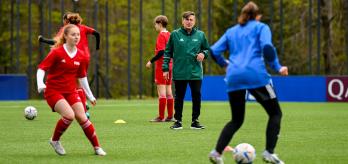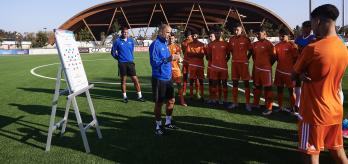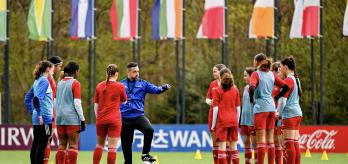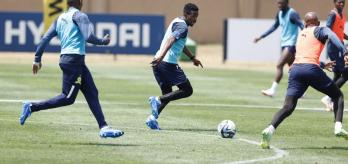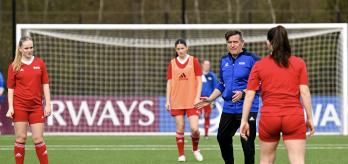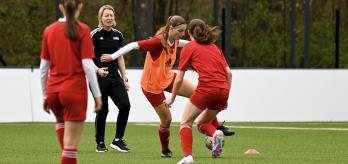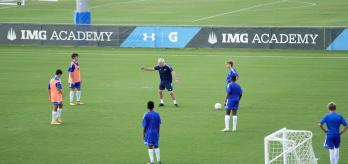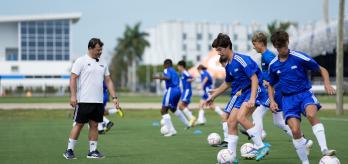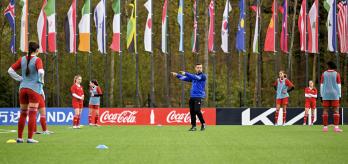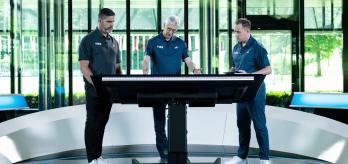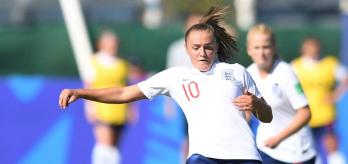If performed consciously and constructively, breaking the opposition’s lines can serve to open the pitch up and result in swift and successful attacks. To break a line, players must be able to receive the ball on the turn and deceive and eliminate pressing opponents from the game.
In this session, FIFA Technical Expert Jonas Urias presents a series of exercises to a group of young girls that focus on breaking opposition lines. Before the exercises get under way and as an introduction to the session, Urias challenges the players to think about the skills that they may require to break opposition lines. Following this cognitive preparation, the first exercise is a simple passing and receiving circuit that acts as a warm-up to prepare the players for the more complex activities later on in the session. The second exercise is a 6v6 game that focuses on breaking the opposition’s first pressing line, and the final exercise involves overcoming the opposition’s midfield press.
Session overview
Key coaching points
-
Receive the ball with a view to turning out in the direction of the next phase of play.
-
Constantly scan and check shoulders to identify the direction of the opposition’s press and where pockets of space may appear to turn and play into.
-
Use body and passing feints to deceive and eliminate opponents from the game to create space.
-
Focus on the quality of the initial pass, which should set the receiver up to turn quickly and seamlessly break the lines.
-
Create pockets of space and passing lanes when operating between the lines.
Introduction: cognitive preparation
Before the players take to the pitch to perform the exercises, it is a good idea to get them to think about all of the actions and strategies that they may need to call upon during the session to break the opposition’s lines. Gather the players together and divide them into two teams.
-
Present the players with several scenarios and ask them to think about how they would go about breaking the opposition’s lines in each of them.
-
Using one flip chart per team, ask the players to draw an image or write down actions that will help them to break opposition lines in each of the scenarios.
-
The players then present their ideas to the other team and the coach.
-
The coach gives feedback and asks further questions.
Part 1: passing and receiving circuit to break lines
This first exercise works on the fundamentals of playing and receiving line-breaking passes. If players are able to receive, turn and pass on the move, it provides them with the platform to work the ball through the opposition’s lines and continue to the next phase of play.
-
Use one half of the pitch.
-
Split the players into two teams and four groups, each of which comprises 3 players.
-
Mark out two adjacent passing circuits per team. Set up each circuit as follows:
-
Station 1 is formed by placing two blue cones 5m apart at one end of the circuit.
-
Station 2 is formed by marking out a 5x5m square 15m from station 1 using four yellow cones.
-
Station 3 is formed by placing two blue cones 15m from, and parallel to, station 2.
-
The second element of station 3 is formed by placing three equally distanced yellow cones 5m beyond the set of blue cones at this station and between the adjacent circuit.
-
Position a player at each of the three stations.
-
The exercise starts with the player at station 1 in possession.
-
The player at station 1 passes the ball to the player at station 2.
-
The player at station 2 receives the ball on the turn inside the 5x5m square.
-
After controlling the ball and turning out, the player at station 2 plays a pass to the player at station 3.
-
The player at station 3 receives the ball before dribbling around the single yellow cone between the two blue cones at their station.
-
The player at station 3 then plays the ball to the player at station 2.
-
The player at station 2 completes the circuit by receiving the ball, turning and passing it back to the player at station 1.
-
Once the players have had the chance to familiarise themselves with the exercise, an element of competition is introduced, with the first team to complete the circuit twice being awarded a point. This element of competition should be retained across all variations.
Variation 1
-
The player at station 2 performs a feint before advancing beyond the middle square to receive the ball. They then dribble the ball through the square before passing to the player at station 3.
Variation 2
-
After receiving the ball inside the middle square, the player at station 2 dribbles around one of the yellow cones that make up the square before passing to the player at station 3.
Variation 3
-
The player at station 2 takes up a starting position slightly in front of the middle square and advances through the yellow cones as the pass is played from the player at station 1 so that they receive the ball on the move at the far end of the square. They then complete the circuit by playing the ball to the player at station 3.
Variation 4
-
The two players on each team at station 2 swap circuits with their counterparts so that they now play with the opposition.
-
The player at station 1 plays a pass into the player at station 2 that is difficult to control.
-
The player at station 2 is tasked with controlling the ball inside the middle square. If they manage to do so, they then dribble around one of the yellow cones that make up the square, before playing a pass to the player at station 3. If the player at station 2 is unable to control the pass within the middle square, the ball is played back to the player at station 1 and the pass is played again.
-
The player at station 3 also plays a pass into the player at station 2 that is difficult to control.
-
Points are awarded when the circuit is completed twice, with the points allocated to the team of the player positioned at station 2.
-
Accurate passes played into the player at station 2 help to improve the efficiency of the circuit.
-
The player at station 2 should constantly drift in and out of the space between the lines.
-
Players should prepare to receive the ball between the lines by being on their toes and adopting an open body shape.
-
Encourage players to receive the ball with a view to turning and playing out in the direction of the next phase of play. The player at station 2 should ensure that they take a good first touch as a platform to play the pass out of the square area.
Part 2: breaking the opposition’s first pressing line
This exercise provides the players with the opportunity to work in real-game situations, in which they are pressed by the opposition and tasked with breaking the first line of the press. The players’ ability to work some space, perform feints and receive the ball on the turn are key elements when it comes to successfully breaking the opposition’s lines.
-
Mark out a 40x30m playing area.
-
Place a full-size goal at one end of the playing area.
-
Position a goalkeeper in the goal.
-
Mark out a line 20m from the goal line or use the edge of penalty area.
-
Place a mini-goal 40m from, and directly opposite, the full-size goal.
-
Place a mini-goal 15m either side of the central mini-goal.
-
Split the group into two teams of six, plus a goalkeeper who plays for the attacking team.
-
The attacking team aim to build up an attack from the goalkeeper, break the pressing team’s lines and score in one of the three mini-goals located at the opposite end of the playing area.
-
The 2 orange centre-backs must remain inside the penalty area at all times.
-
The 2 orange full-backs begin the exercise inside the penalty area but have the freedom to leave the penalty area to help progress play.
-
The orange midfielders are allowed to roam freely, depending on the build-up of play.
-
The 2 blue strikers must remain inside the penalty area and press the ball at all times.
-
The 2 blue midfielders must remain outside of the penalty area at all times.
-
Place 2 blue players behind the mini-goals.
-
One of these blue players can enter the playing area in support but only once the ball has been played to an orange midfielder outside of the penalty area.
-
The orange team are awarded one point if they score in any of the three mini-goals.
-
The blue team are awarded three points if they regain possession and score in the full-size goal.
-
Swap teams to ensure that all of the players get the opportunity to break the opposition’s lines.
Variation 1
-
If the blue team regain possession, the blue players can move freely around the whole playing area.
Variation 2
-
Both blue support players can enter the playing area once the ball has been passed to an orange midfielder. In addition, one of the blue attackers can leave the penalty area to drop back and defend once the line has been broken.
-
Players should perform feints to deceive opposing players and create the space to receive the ball on the turn and break opposition lines with greater ease.
-
Players receiving line-breaking passes should constantly perform shoulder checks and scans to allow them to assess if they have the space to turn and progress play.
-
Players should look to receive the ball on the turn to help them to break the lines more swiftly and efficiently.
-
Full-backs must push forward as soon as the central midfielder receives the ball to offer more passing options in the final third.
-
Be aware of opportunities to receive and turn in central areas (in the pivot role), which is typically the most effective way of breaking the lines.
Part 3: breaking midfield lines
In this exercise, instead of breaking lines to overcome the opposition’s first press, the focus is on breaking the opposition’s midfield line and progressing play into the final third. To overcome the midfield press, players must master passing feints, perform short, sharp movements in tight spaces and have the ability to play accurate passes.
-
Mark out a 40x30m playing area.
-
Place a full-size goal at one end of the playing area.
-
Position a goalkeeper in the goal.
-
Split the group into a 6v6 attack v. defence scenario, plus a goalkeeper, who plays for the defending team.
-
Place 2 orange players at the end of the playing area without a goal and give them one ball.
-
Use cones to mark out a 5v2-metre-long corridor ten metres from the end of the playing area without a goal.
-
Place 2 blue players inside the red corridor.
-
Place 2 blue defenders and 2 orange attackers in the final zone, which runs from the goal line to the edge of the penalty area.
-
The other 2 orange players wait in the wide areas.
-
The aim for the orange team is to pass the ball through the red corridor into one of the 2 strikers.
-
The blue players inside the red corridor try to block off the passes into the 2 orange strikers.
-
The exercise begins with one of the 2 orange players in the first-phase area.
-
Once the ball is passed through the red corridor, the 2 orange wingers become active and join the 2 orange strikers, setting up a 4v2 scenario in the final third as the oranges try to score in an overload situation.
-
The 2 blue players occupying the red corridor must stay inside the corridor at all times.
-
If the blue team win possession, they try to pass the ball through the first-phase zone, while the orange team try to win the ball back.
-
Regularly swap the players occupying the red corridor with the waiting players.
-
One blue player can leave the red corridor to help their team to defend, but only after the line has been broken by playing the ball through the red corridor. In addition, one orange player located in the first-phase zone can move forward and join the attack.
-
Once the ball has been received and a player turns, they should look to pin the centre-back so that they have to engage, which in turn helps to create key passes in the final third.
-
Create line-breaking opportunities by making short, sharp movements while performing passing feints.
-
Players looking to receive the ball beyond the red corridor can hide behind the defending players occupying the corridor before suddenly stepping to one side to create passing lanes.
-
Constantly scan to find pockets of space to receive the ball infield and scan team-mates’ off-the-ball movement to quickly identify forward passing options.
















